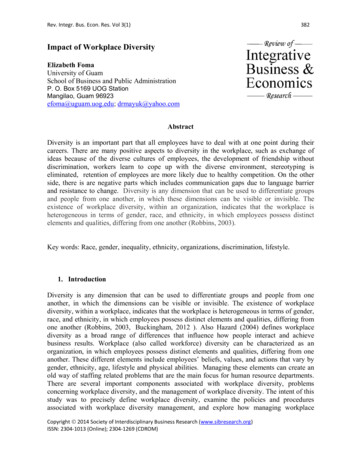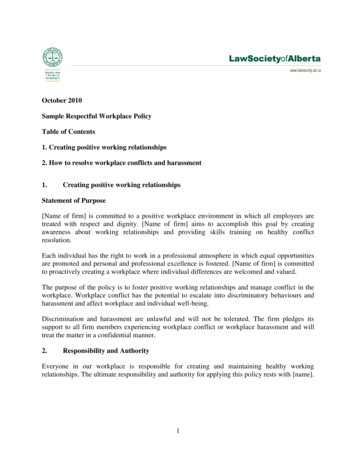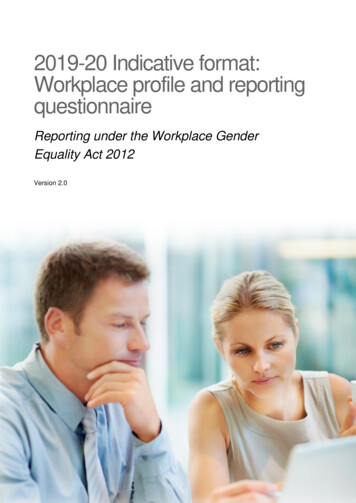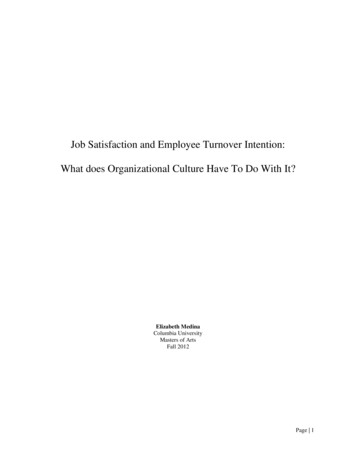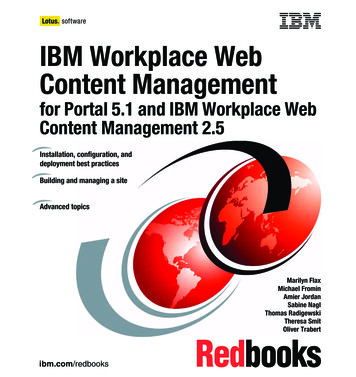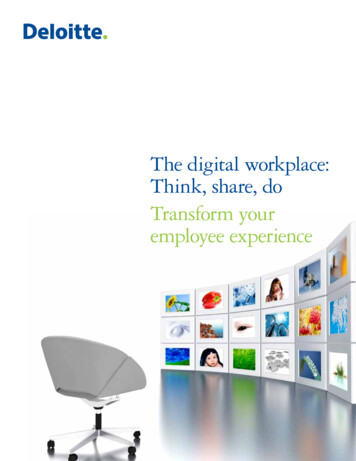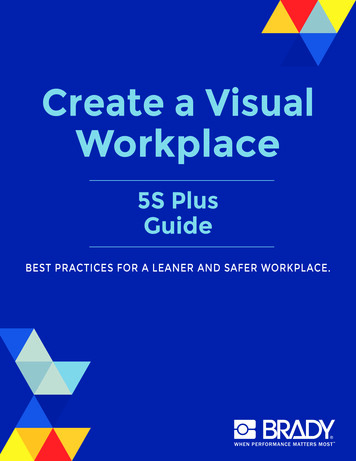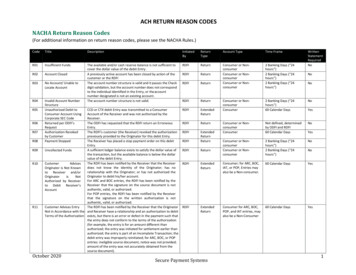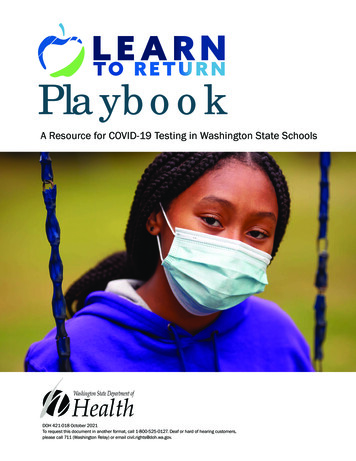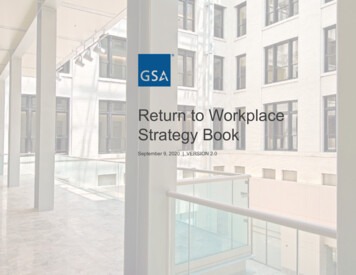
Transcription
Return to WorkplaceStrategy BookSeptember 9, 2020 VERSION 2.0
Return to Workplace Strategy BookBUSINESSPLANNINGWORKPLACEBEHAVIOR OURCESIntroductionOUR COMMITMENTGSA is committed to helping agencies lead a safe and effective returnto on-site operations. This strategy book is a compilation of informationfrom across government and industry that can be used as a frameworkof considerations for returning to GSA owned and leased facilities.We have included practical solutions from GSA’s own return to theworkspace planning, however, the solutions may need to be adaptedto fit your own agency’s needs.The information in this strategy book should not be interpreted asdirectives or requirements from GSA.Your ChargePlan and ReassessThis Book is:We are living in a world that is rapidlychanging, and guidance is constantly beingupdated.Every agency will have its own timeline forreopening offices (most likely in tandemwith continued telework) and shouldconform to the White House memorandum,“Aligning Federal Agency Operations withthe National Guidelines for Opening UpAmerica Again.” Phased reopening isbased on state and local recommendationsfor when it is appropriate to reintroduceemployees to the worksite. A sequence of steps that apply what wehave learned over the past few monthsThe information in this strategy bookrepresents of-the-moment guidance, andyour agency should continue to monitorand adapt reopening and reoccupancyplans as more information is madeavailable by federal and local resources.This strategy book will help your agencydetermine its reopening strategy and is justone tool in your toolkit.After initial reopening, changing localconditions will require agencies to continueto monitor and adapt their plans.In addition to reopening preparations andearly phased occupancy, a review processwill be key. A framework for how to approachdecision making for the future workplace Practical examples for how your agencymay approach a return to facilities plan Intended to complement information fromother federal agency resourcesThis Book is NOT: A step-by-step guide of how to safelyreopen your office A series of directives or requirementsfrom GSA A one-size-fits all solutionRefer to GSA.gov forupdated guidance.2
Return to Workplace Strategy BookWORKPLACEBEHAVIOR AGEADDITIONALRESOURCES3How to Use This Strategy BookThis strategy book guides agencies’ plans for resuming useof administrative offices.Strategy BookOrganizationThis strategy book addresses a wide range ofbusiness, operational, and facilitiesconsiderations for reopening workplaces. Thepoint of view is high-level. Each agency willneed to address specific conditions, location bylocation.Readers can access each section of thestrategy book by clicking on the desiredsection tab at the top of the page.Each section represents a separatesequential strategy for agencies to referencewhen developing their return to workplaceplans.BUSINESS PLANNINGThis section addresses a framework forplanning the timing, approach, and otherelements of reopening. It also offers specificguidance for the phased reopening ofworkplaces.THIS DOCUMENT IS INTERACTIVETHE GSA LOGO WILL LEADTO THE CONTENTS PAGE.CLICK ON THE MENU TITLES TO ACCESSEACH SECTION OF THIS DOCUMENT.UNDERLINED TEXT IS A LIVE HYPERLINK WITHINTHE BODY COPY OF THE INFORMATION.Visit www.gsa.gov for up-to-dateinformation and to find availableproducts and services.WORKPLACE BEHAVIOR ANDOPERATIONSThis section details behavioral and operationalprotocols for individual and shared workspaces,access control, and specifically addressescleaning, disinfection, HVAC and workplacesafety.LINK BOXES PAGES ARE LIVE HYPERLINKS TORESOURCES BOTH WITHIN AND EXTERNAL TO THEDOCUMENT.Lighter colored boxeslink to strategy bookpagesLink to Additional InformationDarker coloredboxes link toexternal websitesLink to Additional InformationFACILITIES READINESSThis section details reopening preparations fora building and its workspaces. Subjects includephysical distancing and space readiness, andprovides guidelines for excess seating, physicalbarriers, occupancy planning considerations,and natural range of movement.The section includes specific considerations for: Reception and waiting areas Open work areasConsiderations include: Circulation Who is requested back to the office, withemphasis on essential on-site functions Individual workspaces Meeting rooms Building and workspace capacity Pantry and breakroom spaces Management of flow and number ofpeople working in the office at one time Common spaces Restrooms Outdoor areasSIGNAGEThis section includes information onsignage in building common areas andwithin a tenant’s space.Also provided is a complete, printablesignage package that can be downloadedfrom gsa.gov.ADDITIONAL RESOURCESThis section discusses future workplacestrategies, desk sharing and provides GSAresources for workplace assistance.
Return to Workplace Strategy BookWORKPLACEBEHAVIOR AGEContentsBusiness Planning5 Facilities ReadinessPhases for Reopening theOffice6Preparing for Reopening7Workplace Behaviorand Operations8Behavior and Etiquette atWorkspaces914 Signage29Universal Considerations15 Workplace Reopening Signage30Agency Receptionand Waiting AreaWorkplace Reopening Signage17 Package31Open Work Area Considerations18Circulation Considerations19Individual WorkspaceConsiderationsAdditional Resources35Desk Sharing3620 GSA Regional WorkplaceExpert NetworkAccess Control10Cleaning and DisinfectingWorkspacesIndividual Workspace PlanningExample11Meeting Room Considerations21 Resources andAcknowledgements24Workplace Safety13Pantry and BreakroomConsiderations25Considerations for OtherCommon Spaces26Restroom Considerations27Outdoor Seating Considerations283738ADDITIONALRESOURCES4
BUSINESSPLANNINGReturn to Workplace Strategy BookWORKPLACEBEHAVIOR &OPERATIONSFACILITIESREADINESSBusiness PlanningThis section includes best practices for workforcereentry. Some concepts shown in this section may notbe applicable for your agency or may be applicable foryour workplaces of the future.The concepts shown are meant to be conversationstarters—not specific solutions.Phases for Reopening the Office6Preparing for Reopening7SIGNAGEADDITIONALRESOURCES5
Return to Workplace Strategy BookBUSINESSPLANNINGWORKPLACEBEHAVIOR OURCES6Phases for Reopening the OfficeDefine a plan for bringing employees back in phases, building inflexibility to reassess and adjust to changing conditions.Link to CDC – Assess Essential FunctionsLink to OPM – FAQsLink to Workplace Decision ToolAssess Supply and DemandDetermine Building CapacityWork with your GSA Building Manager orGSA Lease Administration Manager toassess the number of people that yourbuilding can safely accommodate at onetime.Also consider : Vertical circulation: How many peoplecan stairs and elevators safely supportin the building given physical-distancingconsiderations? Parking capacity: Will there be enoughparking spaces available if more peopledrive to work? Public transportation: Access, availabilityand use of public transportation mayaffect how employees will arrive at theoffice.Determine Workspace CapacityCompare the headcount of in-office staffthat are needed per phase with the buildingcapacity once physical-distancingconsiderations are applied.Determine if the required headcount can beaccommodated within your footprint. If not,re-evaluate the number of staff in eachphase or consider shift work.Also keep in mind that if your agency hasmission-specific spaces (e.g., labs, SCIF,etc.), the reduced capacity of these spacesmay affect the number of people who canreturn to the workplace per phase.GSA’s Total Workplace program hascontracts available to assist agencies withcapacity planning. Contact us atworkplace@gsa.gov for more information.Continual AssessmentA reopening plan also requires a period ofmonitoring and adjustment.The plan should be adapted to evolvingregulations and guidelines. Use federal andlocal guidelines and employee feedback,as well as guidance from your agency orother government agencies, to informthose modifications.
Return to Workplace Strategy BookBUSINESSPLANNINGWORKPLACEBEHAVIOR &OPERATIONSPreparing for ReopeningSupport employees as they make plans for returning to theoffice. Prioritize safety and health in preparations and CESLink to CDC – Considerations for MasksLink to CDC – People at Higher RiskLink to OSHA – Preparing to ReturnLink to CDC – Workplace GuidanceOther ConsiderationsBefore ReopeningVisitor’s PolicyYour agency will determine its visitor’s policyand may decide to limit visitors to onlyessential guests until guidelines change.Childcare Centers in GSA-ControlledBuildingsOperating decisions for childcare centers aremade by providers in consultation with theirBoard of Directors, as applicable. If GSAcloses a building, the childcare center in thatbuilding will also need to close.Local public health authorities can also closechildcare centers. The Centers for DiseaseControl and Prevention (CDC) has issuedguidance on childcare centers.Acquiring, Distributing and UsingPersonal Protective SuppliesEach occupant agency is responsible forestablishing any requirements or guidance formask/face covering usage among itsemployees, contractors, and visitors withinagency space.CDC data indicates that masks/face coveringusage is critical for safe operations ofworkspaces, particularly indoors, andespecially when physical distancing is difficultto maintain.Communicate if supplies will be providedby the agency, and which, if any, agencyprovided supplies may be utilized byemployees outside of the office.Personal protective supplies can beprocured through GSA Advantage!Reasonable accommodation may berequired for an employee whose disabilityprevents or causes difficulty usingpersonal protective supplies.Government Owned Vehicles (GOV)Refer to your agency’s policy on the use ofshared GOVs and the number ofpassengers, since guidance will vary fromagency to agency.Refer to GSA’s Vehicle Cleaning andDisinfecting Guidance for COVID-19 forinformation on how to appropriately cleanshared government vehicles.For vehicle purchasing information, contactGSA Fleet at gsafleet@gsa.gov7
BUSINESSPLANNINGReturn to Workplace Strategy BookWORKPLACEBEHAVIOR &OPERATIONSWorkplace Behavior andOperationsThis section provides direction for workplacereopening, focusing on how behavioral changesimpact facilities operations.The concepts shown are meant to be conversationstarters—not specific solutions.Behavior and Etiquette at Workspaces9Access Control10Cleaning and Disinfecting Workspaces11Workplace CES8
Return to Workplace Strategy BookBUSINESSPLANNINGWORKPLACEBEHAVIOR OURCES9Behavior and Etiquette at WorkspacesSome workspaces call for additional protocols and policies.New Workspace Policiesand ProtocolsShared WorkspacesWhile the workplace will feel familiar, theremay be new ways of working, new policies,and new protocols.Open Collaboration AreasInform employees of any tools that they canuse to reserve open collaboration spaces.Individual WorkspacesMeeting RoomsIndividual spaces include workstations,private and shared offices, and sharedworkstations.Frequent Cleaning by IndividualsEmployees should clean and disinfectfrequently used individual workspacesurfaces and equipment before and afteruse (e.g., desktop, keyboards, chairs,telephones). They should not rely onothers to disinfect surfaces.Cleaning supplies and materials providedby the agency may be for agency use only.Consider the following questions for meetingrooms: Can the in-person meeting be replacedwith a virtual meeting? Can the size of the in-person group belimited? Are you able to use digital alternatives toshared collaborative tools? Can the door be left open during themeeting to decrease the time spent in anenclosed space? Does the room technology support staffwho are participating remotely?Spaces for Wellness and InclusivityIf possible, provide a space reservation tool forbooking Nursing Mother’s, All-Gender andInterfaith Rooms. Consider extendingreservation blocks to allow users to have ampletime to disinfect the rooms before and after use.Other Shared SpacesOther shared spaces include pantries,breakrooms, restrooms, copy/fax/print rooms,and shipping/receiving spaces.Besides asking employees to wear facecoverings/masks and to follow physicaldistancing guidelines in shared workspaces,consider providing cleaning supplies and wipesso that employees have the ability to wipe downhandles/pulls and buttons on personal propertyand equipment (e.g., coffee makers,microwaves, refrigerators, copy machines andphones) in frequently used spaces likebreakrooms and copy rooms.While these shared spaces are cleaned aspart of routine cleaning, each employeehas the opportunity to contribute toward asafer work environment.To purchase cleaning supplies, visit the2020 GSA Annual Supply Catalog. You willfind photos, descriptions and prices forover 7,500 National Stock Numbers(NSNs) of the most commonly purchaseditems, including office supplies, furniture,furnishings and cleaning supplies.For additional ordering options for productsand supplies, visit the Disaster Relief andPandemic Aisle of GSA Advantage! toidentify needed items.
Return to Workplace Strategy BookBUSINESSPLANNINGWORKPLACEBEHAVIOR OURCES10Access ControlMinimize uncertainty and maximize safety by managingentry points, establishing touchless protocols, and definingqueuing at key zones.Space UseEstablishing access control can help youragency set expectations for space use.Because these operations may represent ashift in people’s day-to-day experience,constant and clear communication willimprove adoption.Planning should include consideration of theneeds of employees with disabilities, andagencies should be prepared to handlerequests for reasonable accommodation.Touchless EnvironmentEvaluate the need for touchless devices oradditional services that enable employees toaccess and utilize spaces hands-free.If an agency wishes to make updates to itsspace, please contact your GSA BuildingManager or the GSA Lease AdministrationManager for pricing and approval. Agencieswill need to provide a Reimbursable WorkAuthorization (RWA) through eRETA to fundupdates.Screening and QueuingTo implement enhanced entry screeningprocedures at a GSA-controlled facility, thebuilding’s Facility Security Committee (FSC)must convene and vote to determinewhether enhanced entry screening, elevatorcapacity limitations, and other elements ofaccess control need to be taken intoconsideration.While agencies occupying leased locationsmay require COVID-19 screening for theiremployees or visitors, they cannot imposesuch restrictions on other building occupants.The FSC or the occupant agency shouldcontact the GSA Lease AdministrationManager to determine how to implementscreening procedures within the confines ofthe occupant agency’s space.GSA is responsible for queuing protocols forbuilding lobbies, enhanced entry screeningareas (where applicable), and entry-levelelevator banks within GSA-owned federalbuildings.For additional information on enhanced entryscreening, visit the Returning to GSAFacilities webpage.Visitor Check-in and AccessCommunicate which groups are consideredessential visitors at building and floor entries: General public Business-essential visitors Deliveries Non business-essential visitorsShare the visitor list with security/receptionto ensure that essential visitors have siteaccess.Link to GSA – Returning to GSA FacilitiesConsider check-in and delivery processesthat minimize the sharing of tools andsurfaces while maintaining a streamlinedexperience.If applicable to your agency, considerrestricting delivery of personal packages toreduce package volume.Capacity Limits – ElevatorsWithin GSA-controlled facilities, GSA willwork with each building’s FSC to determinewhether protocols must address the numberof occupants in an elevator.Agencies within leased locations cannotimpose elevator capacity restrictions.One-Way TrafficConsult with your GSA Building Manageror GSA Lease Administration Manager todetermine whether your office entries/exitsmay be designated as one-way. One-waytravel may impact building egress and couldpose safety concerns, so consultation withGSA experts is critical.If designating one-way travel, maintain anopen line of communication with security,reception, and employees, where necessary,to provide critical assessment andrefinement.Density MonitoringOnce the workplace is operational, it isimportant to monitor peak flows andpotential pinch points. This information—most easily retrievable from seat reservationsoftware as well as entry/exit turnstile data—can be collected, analyzed, and assessed ona regular basis, to allow for modificationsand adjustments.Maintain an open line of communication withsecurity, reception, and employees toprovide critical assessment and refinement.
Return to Workplace Strategy BookBUSINESSPLANNINGWORKPLACEBEHAVIOR &OPERATIONSFACILITIESREADINESSCleaning and Disinfecting WorkspacesEmployees want to know that their work environment is notonly clean but is also protected. Different space typesrequire different cleaning protocols.Maintain a Healthy WorkEnvironmentTo successfully reopen, the workplaceshould be a healthy and responsiveenvironment.In all facilities under GSA’s jurisdiction,custody, or control, except for those whereGSA has delegated operation andmaintenance responsibility to a customeragency, GSA will provide cleaningservices as outlined in GSA's NationalCustodial Specification or as otherwisedescribed in a lease agreement.GSA has modified the existing cleaningcontracts for federally owned buildings andis issuing unilateral lease amendments forexisting leases to include disinfectingrequirements for high contact surfaces incommon and high traffic areas (e.g.,handrails, door knobs, light switches,countertops, elevator buttons, sinks, etc.)as part of routine cleaning.Cleaning staff must wipe down all solid,frequently touched surfaces in buildingcommon areas (defined as those areas usedor accessed by the government’s employeesand visitors) at least daily and must use adisinfectant from the EPA List N and theother disinfectant options as noted by CDC.Cleaning staff must use products accordingto the manufacturer's directions. Cleaningstaff must wear disposable gloves (e.g.,latex, nitrile, etc.), masks/face coverings, andany additional personal protective equipment(PPE) that the cleaning and disinfectantproduct manufacturers recommend andchoose disinfection applications andproducts that won’t damage interior finishesor furnishings.No specific action is required by occupantsduring the routine daily cleaning.SIGNAGEADDITIONALRESOURCES11Link to CDC – Guidance for CleaningLink to OSHA – Protecting EmployeesLink to GSA – Cleaning and DisinfectionLink to EPA’s List N: Approved ProductsIn some instances, agencies can requesthigher levels of cleaning via an RWAthrough eRETA. Agencies are not requiredto increase the cleaning frequency orcontract for additional cleaning, sincemitigation measures (e.g., physicaldistancing, hand washing, masks/facecovering use, and routine disinfection) areconsidered to be sufficient protection.However, an agency may request and fundadditional cleaning if they so choose.An occupant agency is responsible forcleaning and disinfecting its individualworkspaces, as well as government-issuedpersonal peripheral property such ascomputers and screens, keyboards,computer mice, and telephones.Agencies may discuss cleaning frequencyand protocols with their building managerand/or building management staff.
Return to Workplace Strategy BookBUSINESSPLANNINGWORKPLACEBEHAVIOR &OPERATIONSFACILITIESREADINESSSIGNAGECleaning and Disinfecting WorkspacesEmployees want to know that their work environment is notonly clean but is also protected. Different space typesrequire different cleaning protocols.GSA’s Incident ResponseIf a COVID-19 incident occurs in a GSAcontrolled federal building, GSA will notify thedesignated points of contact for the buildingoccupants as soon as possible, but not later than24 hours after the incident was first reported toGSA.A COVID-19 incident is defined as an instancewhen someone who is confirmed or suspected tohave COVID-19 enters or occupies a building.If there is a confirmed or suspected COVID-19incident in a GSA building, the portion of thefacility accessed by the infected individual(s) willbe cleaned and disinfected per CDC’s guidance. For federally owned facilities under GSA’sjurisdiction, custody or control, cleaning anddisinfecting is handled through an independentcontract, service contract or other similarmeans. Incidents in facilities leased by GSA will becoordinated through the lessor. Incidents at fully delegated buildings will behandled by the customer agency that has beendelegated such authority.Refer to gsa.gov for additional informationon cleaning and disinfection in federal andleased locations.12Link to CDC – Guidance for CleaningLink to OSHA – Protecting EmployeesLink to GSA – Cleaning and DisinfectionLink to EPA’s List N: Approved ProductsDisinfection SuppliesCleaning in response to a COVID-19incident in a building may require occupantsto move out of a space temporarily. Suchcleaning requires the affected area to beisolated until cleaning is completed.ADDITIONALRESOURCESAn agency may wish to provide disinfectantwipes or sprays in common and shared spaceand throughout the office for employees touse for individual workspace cleaning.Encourage employees to wipe down allsurfaces and equipment before and after use.Cleaning supplies and materials provided bythe agency may be for agency use only.Consider placing additional waste binsthroughout the workplace to accommodateincreased waste from frequent disinfecting ofhands and surfaces.Employees’ active participation toward theprotection of the public health in theworkplace is important. Each employee hasthe opportunity to contribute toward a saferwork environment.
Return to Workplace Strategy BookBUSINESSPLANNINGWORKPLACEBEHAVIOR OURCES13Link to CDC – Guidance for BusinessWorkplace SafetyLink to CDC – Worker Safety & SupportLink to EPA - Air Cleaners & HVAC FiltersBehavioral change, coupled with environmentalfactors, can help prevent infection.Link to EPA – Indoor Air and CoronavirusLink to OSHA – Hazard IdentificationLink to OSHA – Preparing WorkplacesOccupant Emergency PlanSafety in the WorkplaceWorkplace safety relies upon the employersetting policies, training workers in thosepolicies, and upon employees followingthem. We have highlighted key policy andprotocol considerations that relate to workplace operations. Links are provided foragencies that publish other definitiveinformation about workplace safety.Engineering ControlsEngineering controls and safe workpractices can be used to respond toCOVID-19 hazards in the workplace.Engineering controls involve physicalbarriers (e.g., installing partitions andsneeze guards) and building systems(e.g., installing high-efficiency air filtersand increasing ventilation rates). Forinformation on physical barriers, refer tothe Facilities Readiness section of thisstrategy book.Building SystemsBuilding systems such as heating,ventilation and air conditioning (HVAC) areessential for maintaining a healthy workenvironment.Work closely with your GSA BuildingManager or the GSA Lease AdministrationManager on the timing and planning foryour agency’s return to the workplace.In GSA-operated buildings, the CDC’sHVAC recommendations will beincorporated based on existing equipment,current configuration, and reoccupancyschedule, including disabling demandcontrol ventilation, increasing operatinghours, increasing use of outside air,ensuring air filters are properly sealed, andupgrading air handler filtration efficiency.GSA is documenting the specific actionstaken and planned for each governmentowned, non-delegated building and willshare with the occupant agencies. Theinformation will be shared with agency pointsof contact and will cover HVAC systems, airfiltration and plumbing systems.GSA is notifying lessors for all active GSAleases that they are expected to followcurrent industry practices by considering theapplication of the latest CDC guidanceconcerning building ventilation and watersystems.These building ventilation and watersystems guidelines are located in the CDCInterim Guidance for Businesses andEmployers Responding to CoronavirusDisease 2019 (COVID-19), May 2020, undersections “Consider improving theengineering controls using the buildingventilation system” and “Ensure the safety ofyour building water system and devices aftera prolonged shutdown.”In accordance with current CDC guidance,GSA recommends lessors considermodifying the engineering controls usingthe building ventilation system, which mayinclude some or all of the followingactivities: Increasing ventilation rates Ensure ventilation systems operateproperly and provide acceptable indoorair quality for the current occupancylevel for each space. Increase outdoor air ventilation, aftertaking into account the outdoor airquality of the surrounding area. Disable demand-controlled ventilation(DCV). Further open minimum outdoor airdampers (as high as 100%) to reduce oreliminate recirculation. In mild weather,this step should not affect thermalcomfort or humidity. However, this maybe difficult to do in cold or hot weather. Improve central air filtration to theMERV-13 or the highest compatible filterwith the filter rack, and seal edges of thefilter to limit bypass. Check filters to ensure they are withinservice life and appropriately installed. Extend operating hours of systems toincrease air exchanges in the buildingspace.As buildings are being reoccupied, GSA FacilityMangers are reminded to review the currentOccupant Emergency Plan (OEP) and makerevisions to the evacuation procedures based onwhich occupants return to the workplace.Some facilities are being reoccupied in phases,and some of the individuals with specificresponsibilities who assist in a buildingevacuation (e.g., floor wardens, stair wardens,etc.) may not yet have returned to the facility.If designated assembly/rally points outside of thebuilding have changed, or those individualsneeding assistance during the evacuation havechanged, this will need to be reflected in theupdated OEP.The OEP should reflect current officeprocedures, such as teleworking and otheractivities. The OEP review will be able toestablish the minimum requirements with respectto how to maintain physical distancing,requirements for mask/face covering usage, andhow to process occupants re-entering thebuilding following an evacuation.The OEP is just one element of the building’semergency management program. It is assumedthat as the federal facilities are repopulated, theupdated OEP and information related to theemergency’s evacuation procedures are sharedwith the returning occupants as part of thecommunication associated with the COVID-19procedures.
BUSINESSPLANNINGReturn to Workplace Strategy BookFacilities ReadinessWORKPLACEBEHAVIOR &OPERATIONSThis section focuses on reopening preparationsfor facilities and work areas commonly found inadministrative offices, using diagrams to illustrateconcepts.The concepts shown are meant to be conversationstarters—not specific solutions.Universal Considerations15Agency Reception and Waiting Area17Open Work Area Considerations18Circulation Considerations19Individual Workspace Considerations20Individual Workspace Planning Example21Meeting Room Considerations24Pantry and Breakroom Considerations25Considerations for Other Common Spaces26Restroom Considerations27Outdoor Seating ALRESOURCES14
Return to Workplace Strategy BookBUSINESSPLANNINGWORKPLACEBEHAVIOR OURCES15Universal ConsiderationsThese are overarching considerations that either addressthe building as a whole or apply to multiple space types.Physical DistancingTouchless ExperiencePhysical distancing is a key factor inmitigating the spread of COVID-19.Planning for physical distancing is a keyprinciple in creating facility readiness.In addition to maintaining a cleaner facility,consider looking for solutions that minimizepeople’s contact with surfaces.The CDC has recommended distancesto maintain. You should base your facilityplanning on CDC guidance.Please note that we are intentionally notreferencing a specific physical distancethroughout this document or within thesignage package so that if physicaldistancing guidance changes, this materialremains current.Agencies who wish to install automatichold-open devices on doors should consultwith the GSA Building Manager or LeaseAdministration Manager and the GSARegional Fire Protection Program Office.Plans for installing hold-open devices ondoors must be reviewed by the GSA FireProtection Officer.Requests to modify tenant spaces andinstall touchless features in restrooms(e.g., motion activated toilets, faucets, andtowel dispensers) must be approved byGSA or lessor and may require an RWA.Link to CDC – Guidance for BusinessNatural Range ofMovementPeople do not always sit at the same spotat their workstations. Instead, there is anatural range of movement within thefootprint of each individual workspace.Similarly, when preparing a cup of coffee ina breakroom, a person may move quicklyfrom the cabinet to the coffee machine, thento the refrigerator. The areas in front of
Sep 09, 2020 · The information in this strategy book decision making for the future workplace “Aligning Federal Agency Operations with represents of-the-moment guidance, and Practical examples for how your agency the National Guidelines for Opening Up your agency should continue to monitor
